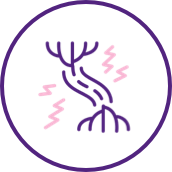R&D pipeline
These programs are investigating treatments or outcomes that have not all received approval from a health authority. The information presented is not intended to convey conclusions of safety or efficacy. There is no guarantee that the outcome of these studies will result in approval by a health authority.
Vertex is focused on discovering, developing and producing innovative medicines so people with serious diseases can lead better lives. Our scientists don’t see the impossible as an obstacle; they see it as a good place to start.
We have a unique way of building our drug discovery programs to maximize their chances of creating therapies that may dramatically improve patients’ lives. Our focus is on serious diseases where we could truly have a transformative impact for patients, not just an incremental benefit.
We work only on projects where we have a deep understanding of the underlying cause of disease in humans. Then we research and develop therapeutic approaches that are most likely to succeed. Rather than looking for problems we can solve with only the tools we’ve used before, we figure out the problems that need to be solved for the diseases we’re going after and invent the tools to potentially fix them.

These programs are investigating treatments or outcomes that have not all received approval from a health authority. The information presented is not intended to convey conclusions of safety or efficacy. There is no guarantee that the outcome of these studies will result in approval by a health authority.
Vertex is focused on discovering, developing and producing innovative medicines so people with serious diseases can lead better lives. Our scientists don’t see the impossible as an obstacle; they see it as a good place to start.
We have a unique way of building our drug discovery programs to maximize their chances of creating therapies that may dramatically improve patients’ lives. Our focus is on serious diseases where we could truly have a transformative impact for patients, not just an incremental benefit.
We work only on projects where we have a deep understanding of the underlying cause of disease in humans. Then we research and develop therapeutic approaches that are most likely to succeed. Rather than looking for problems we can solve with only the tools we’ve used before, we figure out the problems that need to be solved for the diseases we’re going after and invent the tools to potentially fix them.
We continue to research a portfolio of small molecules as potential medicines for the treatment of AATD.
We're investigating inaxaplin, aimed at inhibiting the function of the APOL1 protein.
We continue to research and develop a portfolio of small molecule inhibitors for the potential treatment of AMKD.
We are investigating VX-407 for the treatment of ADPKD in patients with a subset of PKD1 genetic variants, with the aim of restoring function to the polycystin 1 (PC1) protein.
We are submitting regulatory filings globally for geographic expansion. For information about ongoing clinical studies in the U.S., visit our clinical trials website. For information about non-U.S. sites, visit clinicaltrials.gov.
We’re investigating multiple approaches to develop an additional conditioning regimen for people living with transfusion-dependent beta thalassemia.
We’re researching in vivo gene editing approaches to target the underlying cause of transfusion-dependent beta thalassemia.
We’re investigating small molecule medicines to target the underlying cause of transfusion-dependent beta thalassemia.
We are submitting regulatory filings globally for geographic expansion and/or label expansions. For information about ongoing clinical studies in the U.S., visit our clinical trials website. For information about non-U.S. sites, visit clinicaltrials.gov.
We are submitting regulatory filings globally for geographic expansion and/or label expansions. For information about ongoing clinical studies in the U.S., visit our clinical trials website. For information about non-U.S. sites, visit clinicaltrials.gov.
We are submitting regulatory filings globally for geographic expansion and/or label expansions. For information about ongoing clinical studies in the U.S., visit our clinical trials website. For information about non-U.S. sites, visit clinicaltrials.gov.
We are submitting regulatory filings globally for geographic expansion and/or label expansions. For information about ongoing clinical studies in the U.S., visit our clinical trials website. For information about non-U.S. sites, visit clinicaltrials.gov.
We are submitting regulatory filings globally for geographic expansion and/or label expansions. For information about ongoing clinical studies in the U.S., visit our clinical trials website. For information about non-U.S. sites, visit clinicaltrials.gov.
We are investigating VX-522, a CFTR mRNA that can be delivered to the lung by lipid nanoparticles to address the underlying cause of CF lung disease in approximately 5,000 people with CF who do not make any CFTR protein that responds to a CFTR modulator therapy.
For information about ongoing clinical studies in the U.S., visit our clinical trials website. For information about non-U.S. sites, visit clinicaltrials.gov.
We’re investigating a portfolio of other small molecule medicines targeting the underlying cause of CF with the aim of achieving carrier levels of CFTR function. This includes CFTR potentiators, which are designed to keep CFTR proteins at the cell surface open longer to improve the flow of salt and water across cell membranes, helping to hydrate and clear mucus from the airways. We’re also researching additional small molecules to address the trafficking and processing defect of the CFTR protein to enable it to move through cells and reach the surface.
We’re investigating potential treatments for people with CF who do not make any CFTR protein. We are investing in our own science and with our external partners CRISPR and Moderna to develop other potential approaches with an aim to treat approximately 5,000 people who do not make any CFTR protein that responds to a CFTR modulator therapy. Our efforts to discover and develop therapies to reach as many people as possible with CF through alternative investigational technologies, like mRNA therapies, have been underway for years.
We are investigating novel approaches to treating DMD with the goal of restoring near-full length dystrophin protein expression by targeting certain mutations in the dystrophin gene that cause the disease.
We are investigating povetacicept with the goal of targeting the underlying cause of IgAN.
We are investigating VX-670, an oligonucleotide approach using an intracellular Endosomal Escape Vehicle (EEV™) aimed at targeting the underlying cause of DM1.
We are investigating small molecule approaches aimed at targeting the underlying cause of DM1.
We continue to discover, research and develop a portfolio of small molecules as potential nonopioid medicines for the treatment of acute pain.
We continue to discover, research and develop a portfolio of small molecules as potential nonopioid medicines for the treatment of neuropathic pain.
We continue to discover, research and develop a portfolio of small molecules as potential nonopioid medicines for the treatment of neuropathic pain.
We continue to discover, research and develop a portfolio of small molecules as potential nonopioid medicines for the treatment of acute and neuropathic pain.
We are submitting regulatory filings globally for geographic expansion. For information about ongoing clinical studies in the U.S., visit our clinical trials website. For information about non-U.S. sites, visit clinicaltrials.gov.
We’re investigating multiple approaches to develop an additional conditioning regimen for people living with SCD.
We’re researching in vivo gene editing approaches to target the underlying cause of SCD.
We’re investigating small molecule medicines to target the underlying cause of SCD.
We're investigating zimislecel (formerly VX-880), an allogeneic stem cell-derived, fully differentiated, insulin-producing islet cell therapy manufactured using proprietary technology. It is being evaluated for patients who have T1D with impaired hypoglycemic awareness and severe hypoglycemia. Zimislecel is being investigated as an infusion into the hepatic portal vein and requires anti-rejection medication in an effort to protect the islet cells from immune rejection.
We're investigating VX-264, an approach encapsulating cells in a protective device to be surgically implanted in the body. VX-264 is being evaluated without the use of anti-rejection medication as the devices are designed to shield the cells from the body's immune system.
We're investigating hypoimmune cell therapy approaches which involve using gene editing on the same stem cell-derived, fully differentiated VX-880 islet cells, with the aim to protect the cells from the immune system.









